Extra gravel and extra climbs make 2024 Strade Bianche harder than ever
'It’ll be more difficult for a solo attack to go clear' predicts Alberto Bettiol
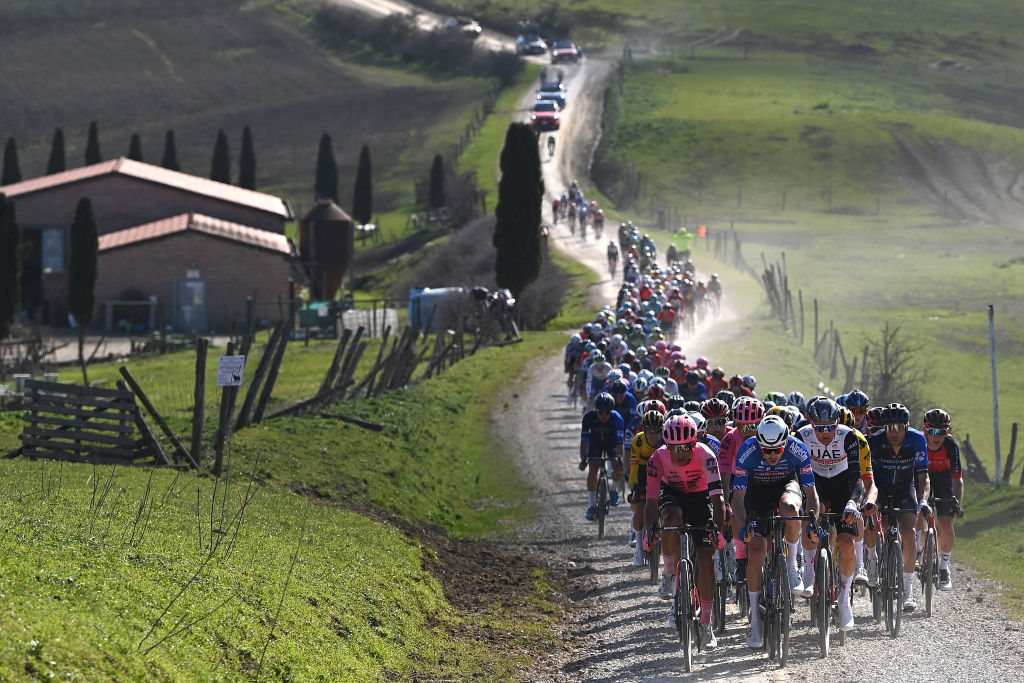
The 2024 editions of Strade Bianche include an extra loop of hilly racing through the Tuscan vineyards and more gravel sectors than ever before, elevating the races closer to Monument status. Yet the changes could create different races for the men and women, that tips the balance in favour of climbers and so reducing the chances of the Classics riders.
Tadej Pogačar (UAE Team Emirates), Tom Pidcock (Ineos Grenadiers), Demi Vollering and Lotte Kopecky (both SD Worx-Protime) are arguably multi-talented but the new route could suit UAE Tour winner Lennert Van Eetvelt (Lotto Dstny) and Simon Yates (Jayco-AlUla) on the men's side, but prove too tough for the likes of Matej Mohorič (Bahrain Victorious), Julian Alaphilippe (Soudal-QuickStep) and Stefan Küng (Groupama-FDJ).
A tougher course should favour Kopecky and defending champion Vollering, but could leans the scales toward Shirin van Anrooij (Lidl-Trek) and Kasia Niewiadoma (Canyon-SRAM).
Whoever wants to climb between the crowd on Via Santa Caterina and then triumph in Piazza del Campo will need the bike skills for the Tuscan gravel and the ability to climb the steep climbs.
Alberto Bettiol is from the Tuscan countryside between Florence and Siena and did a special early reconnaissance ride for his EF Education-EasyPost teammates. He hinted that the now 215km long men’s Strade Bianche is out of his reach but could suit his teammates Richard Carapaz, Neilson Powless or Ben Healy.
“I went to see the new loop about a month ago. There’s nothing that we haven’t seen before or see every year at Strade Bianche but for sure the extra loop makes the race longer and harder,” Bettiol told Cyclingnews.
Other riders began to arrive in Tuscany on Wednesday, including Pidcock, and quickly began several days of reconnaissance rides and training in the area as the rain eased and began to dry out the gravel roads.
Get The Leadout Newsletter
The latest race content, interviews, features, reviews and expert buying guides, direct to your inbox!
US national road champion Quinn Simmons arrived at the start of the week with his family. Strade Bianche has been a personal goal for him since he made the big-name selection in 2021, only for a puncture to end his chances. He was seventh in 2022 when Pogačar attacked alone and hoped for a similar result, despite the tougher course.
“Strade Bianche is the race I look forward to most in the season. In my previous three experiences I learned about the route, its pitfalls, how and where the race can explode, as well as how to play my cards,” Simmons said.
“The new course adds an unknown, but it might not change the story of the race. We have always seen the best riders winning, regardless of the race it’s 180 or 215 kilometres. In the end, maybe the new course will only prolong the show and our suffering.”
Elisa Longo Borghini leads the Lidl-Trek women’s team and impressed with a strong third place at Omloop Het Nieuwsblad behind Marianne Vos (Visma-Lease a Bike) and Kopecky. She won Strade Bianche in 2017 but the longer, harder 137km women’s route could suit her.
“I expect a more selective race than in the past, especially if the weather is not so good,” she said.
“The final circuit adds a significant variable to the course, especially in the finale. It will not be easy to read. For sure, it will be a super exciting race to follow and, for us in the peloton, a very unpredictable challenge to face.”
Strade Bianche 2024 course changes
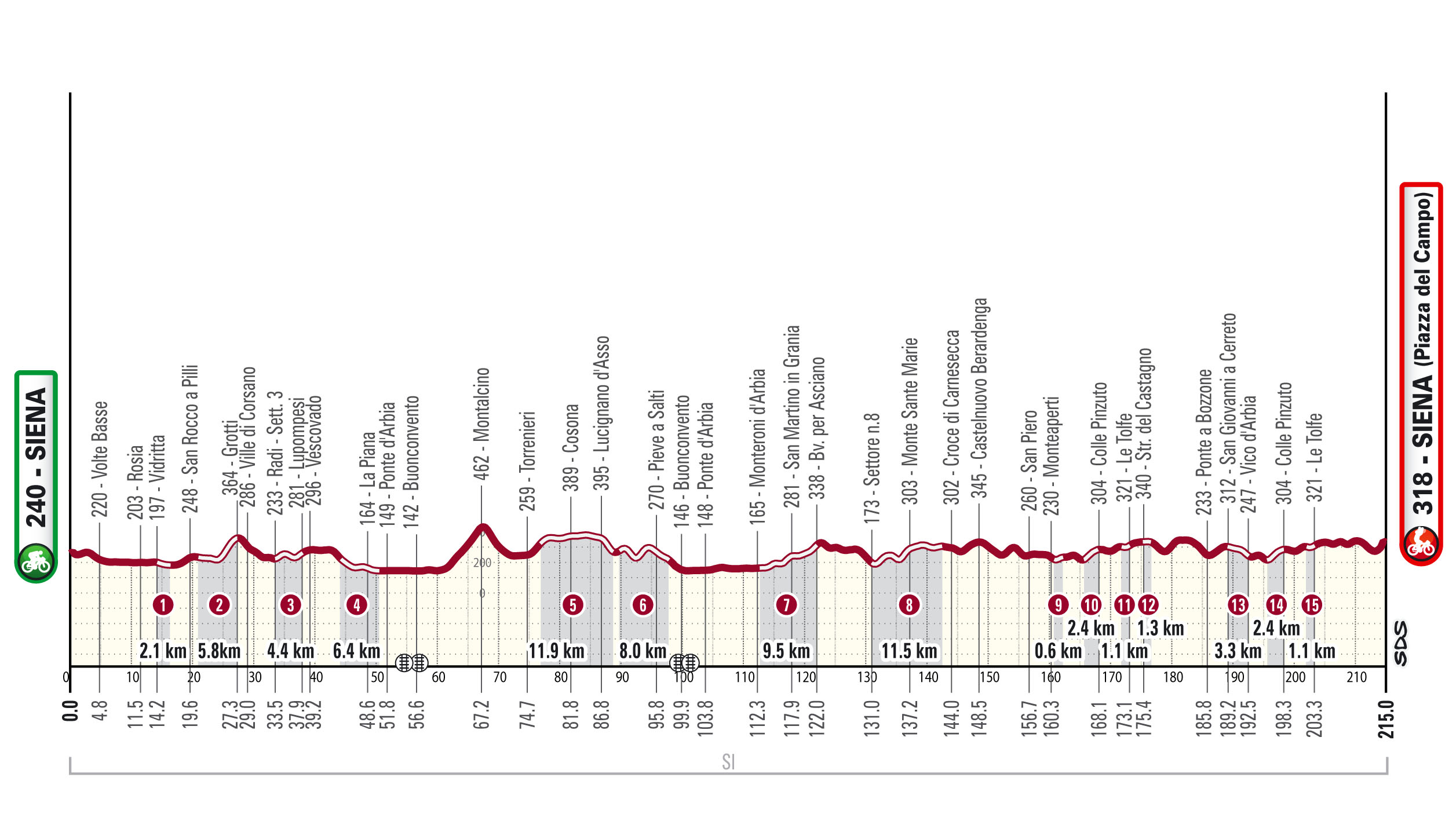
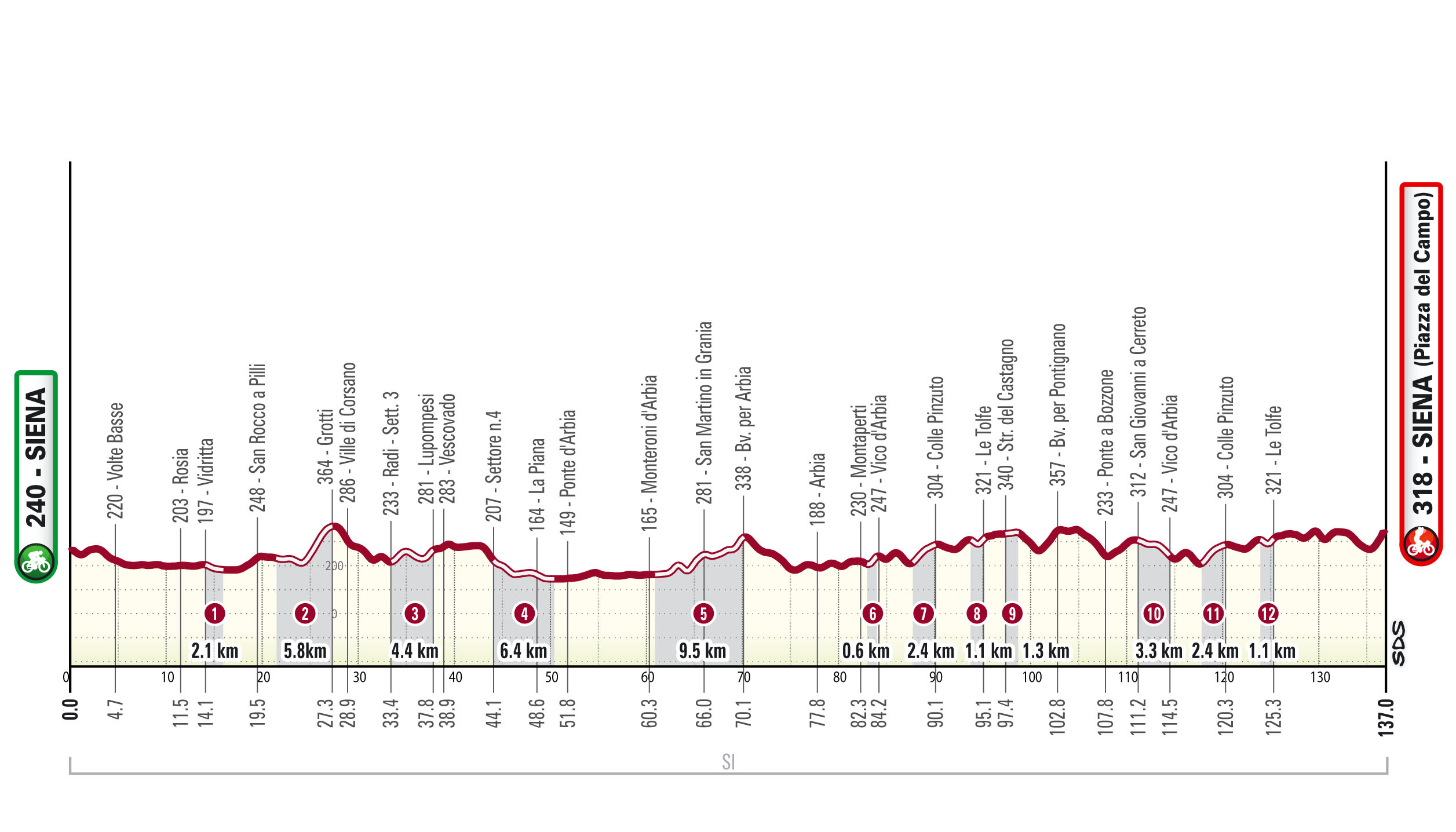
This year the women’s Strade Bianche includes 12 gravel sectors for a total of 39.8km on the ‘white road’ that connect the Chianti vineyards, olive trees and hilltop farms and villages.
The men’s race covered 184km before but the extra loop near Siena over the Colle Pinzuto and Le Tolfe gravel roads extends the distance beyond the psychological 200km barrier to an exact distance of 215km. There are 15 sectors instead of the previous 11, with a total of 71.5km on the farm tracks.
Both races start in Siena and descend south into the fields and stunning exposed Crete hills towards Montalcino. The most important gravel sectors begin on the ride back towards Siena.
The women’s race is likely to blow apart on the 9.5km San Martino di Grania sector after 60km, with the two loops of the Colle Pinzuto and Le Tolfe including seven shorter but often steep sectors to launch attacks. The second climb of Le Tolfe ends just 12.5km from the finish in Siena.
The men’s race will come alive after 130km of country lanes and gravel roads south of Siena. The San Martino di Grania sector lines out the peloton and then the 11.5km Monte Sante Marie sector (8 of 15), always causes the first selection. Anyone who suffers a puncture or crash after her has little chance of getting back to the front despite teams positioning staff with wheels and bidons sling the course like at Paris-Roubaix.
The two loops of the Colle Pinzuto gravel climb and Le Tolfe sector begin after 168km of the men’s race this year.
The 30.2km loop also includes other gravel sectors and some nasty climbs in the hills northeast of Siena, offering at least four perfect points to attack, depending on how audacious the riders are feeling.
Pidcock attacked on the fast Monte Sante Marie gravel descent in 2023, crossed to the early break and was never seen again. Pogačar pulled off a similar audacious attack when he won in 2021. They both covered the Colle Pinzuto and Le Tolfe out front.
In 2021, Mathieu van der Poel made his now famous attack on Le Tolfe dirt sector, where only Alaphilippe and Egan Bernal were able to stay with him. The Dutchman then dropped them on the Via Santa Caterina climb into the heart of Siena to win alone on the Piazza del Campo.
Sadly, Van der Poel has opted to miss this year’s Strade Bianche after peaking for the UCI Cyclocross World Championships and with the Cobbled Classics as a major goal. The difficulty of the new Strade Bianche route was perhaps also a factor in his and Wout van Aert’s decision to miss the 2024 race. Strade Bianche is too hard to be a training race or a stepping stone to something else.

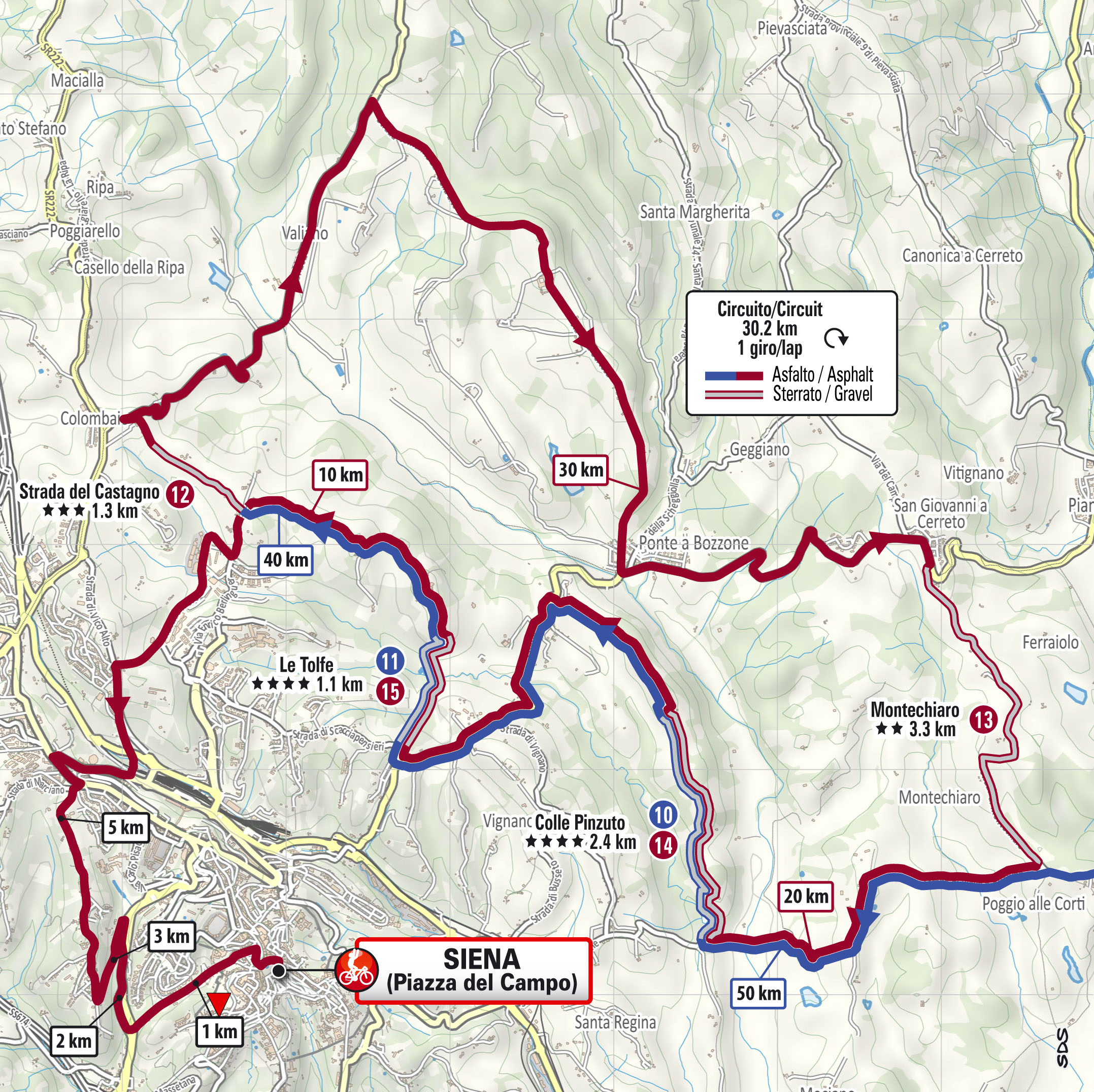
'They are ruining Strade Bianche by making it longer' suggests Michel Wuyts
“With such a hard race on gravel roads and steep climbs, the best riders will emerge yet again but the extra kilometres and extra dirt section and climbs, the race will open up later on. I think it’ll be more difficult for a solo attack to go clear like Tadej Pogačar and Tom Pidcock did in the last two years,” Bettiol suggested to Cyclingnews.
“There will still be hard racing before the circuits and especially on the long Monte Sante Marie sector but the race might not split up off the front but there'll be a huge selection out of the back of the peloton as riders suffer."
The final Le Tolfe sector ends 12km from Siena, with the race to the hilltop top town usually a pursuit match of the strongest riders. After the 15 gravel sectors and many climbs, just one difficulty remains - the steep climb up Via Santa Caterina on the western edge of Siena.
The large, stone-paved road climbs gradually then ramps up, with 16% maximum gradient near the top and the right turn into the central streets. It was here that Van Aert came to a standstill in 2018 and then struggled to get back in the saddle due to the fatigue of the race.
Belgian television commentator Michel Wuyts suggested the extra 30km loop of the Colle Pinzuto and Le Tolfe gravel sectors makes 2024 Strade Bianche harder and so the race will remain controlled for longer, perhaps stifling, long-range attacks.
“They are ruining Strade Bianche by making it longer,” he said in a podcast for the Belgian newspaper Het Nieuwsblad. “By making the course even tougher, I fear it will be closed for a long time.”
He could be right but whatever the changes, whatever the weather and whatever the racing on Saturday, the best rider will emerge on the gravel roads and up the Via Santa Caterina climb to win in Siena.
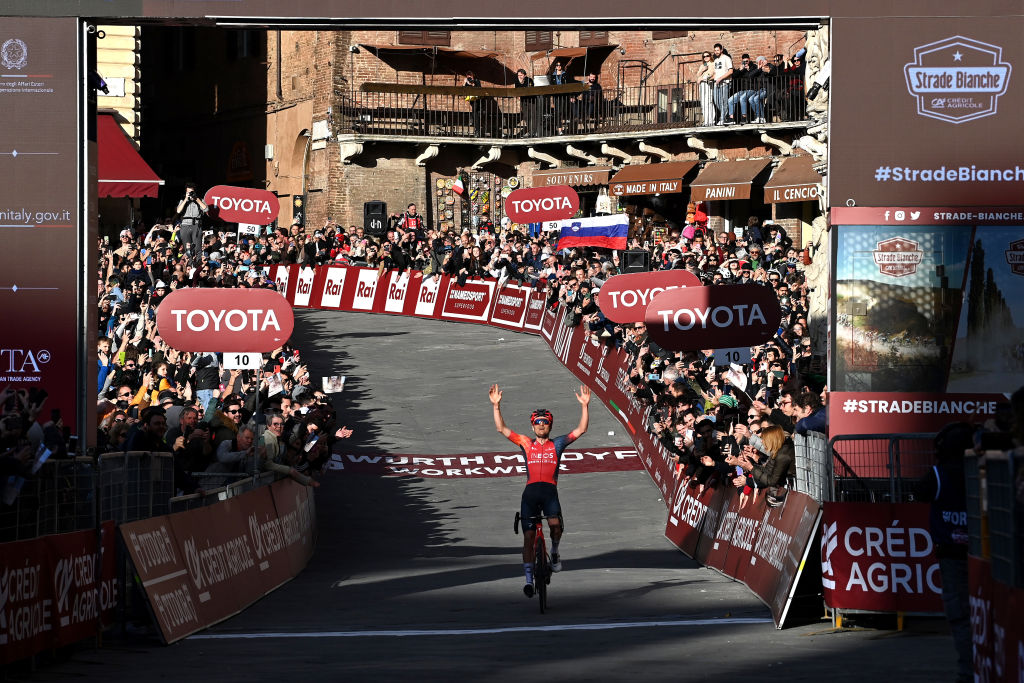

Stephen is one of the most experienced member of the Cyclingnews team, having reported on professional cycling since 1994. He has been Head of News at Cyclingnews since 2022, before which he held the position of European editor since 2012 and previously worked for Reuters, Shift Active Media, and CyclingWeekly, among other publications.